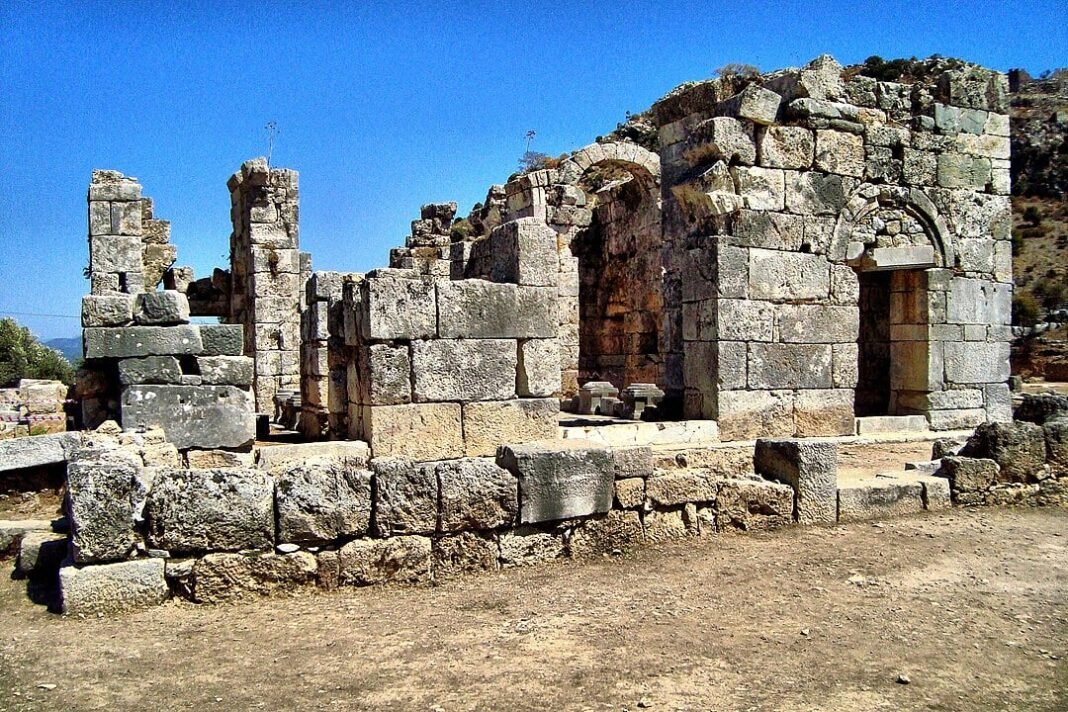
Archaeologists in southwestern Turkey have uncovered a remarkable architectural transformation in the ancient city of Kaunos (Greek: Καῦνος), revealing how a Roman hospital was later converted into a Byzantine church within a monastic complex.
The discovery offers rare insight into how one of Anatolia’s key port cities evolved from a place of healing to a center of Christian worship.
A city of tombs, theaters, and timeless culture
Kaunos, located in what is today Mugla’s Koycegiz district, Turkey, and listed on UNESCO’s World Heritage Tentative List, is already famous for its Hellenistic rock-cut tombs, Greek and later Roman 5000-seat theater, and its two thousand year old baths and mosaics.
The new findings expose another side of its history—showing how medicine, religion, and daily life intertwined across successive civilizations.
Excavations trace the site’s ancient medical roots
The excavations, led by Associate Professor Ufuk Çörtük of Muğla Sıtkı Koçman University, have focused on the Archaic walled monastery area. Over the past three years, Çörtük’s team has unearthed layers of ruins and artifacts documenting more than a millennium of continuous use.
The earliest structures date to the second and third centuries CE, when the site served as a Roman medical complex, identified through the discovery of numerous surgical instruments.
A Roman hospital at a bustling port
The Roman building featured a courtyard surrounded by rooms, a design typical of early hospitals that began as military facilities before opening to civilians.
📍 Muğla’nın Köyceğiz ilçesindeki Kaunos Antik Kenti’nde yürütülen kazılarda kilise gün yüzüne çıkarıldı.
Muğla Sıtkı Koçman Üniversitesi Arkeoloji Bölümü Öğretim Üyesi ve Kazı Başkanı Doç. Dr. Ufuk Çörtük, manastır bölgesindeki Geç Antik Çağ’a ait yapı kompleksinde 3 yıldır… pic.twitter.com/TMjtAb0D61
— arkeolojihaber ® (@arkeolojihaber) October 15, 2025
Its position near Kaunos’s ancient harbor suggests it served both residents and travelers arriving from across the eastern Mediterranean, reflecting the city’s role as a bridge between Greek, Roman, and Anatolian cultures.
From healing to faith: a Byzantine transformation
By the sixth century CE, the complex was drastically transformed. Archaeologists found a large Christian church built directly atop the Roman foundations, marking the emergence of a Byzantine monastic complex.
The church remains remarkably well-preserved, illustrating how Kaunos shifted a Roman healing place to a Byzantine spiritual center, while maintaining architectural continuity through changing eras.
Medieval traces mark the site’s endurance
Evidence also points to later occupation. A coin belonging to Aydın Mehmed Bey of the Aydınoğulları Beylik, a 14th-century Turkish principality, confirms that the site remained active into the medieval period.

Çörtük said Kaunos experienced four to five distinct phases of use, from the Roman period through the Turkish-Islamic era, reflecting its enduring adaptability.
A living timeline of culture and belief
Researchers describe the site as a “living timeline” of Kaunos’s transformation under shifting empires and beliefs. Hellenistic, Roman, Byzantine, and later part of the Turkish Anatolian world, the site embodies the city’s continuous reinvention over centuries.
The discovery highlights how Kaunos—once one of ancient Caria’s most important Greek-influenced port cities—stood at the crossroads of medicine, faith, and civilization in the eastern Mediterranean.


